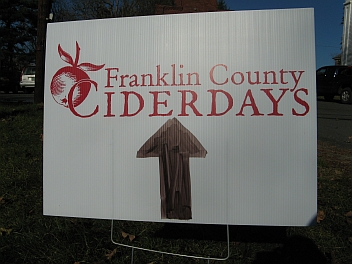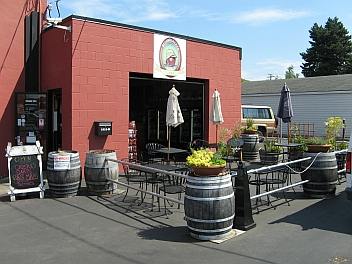This is Part 1 of a series that aims to increase your understanding of and appreciation for well-made cider. These posts are written with a US audience in mind, but many of the suggestions will apply wherever you reside.
1) Taste – Find and try as many ciders as you can.
2) Evaluate – Translate your sensory data into coherent thoughts.
3) Judge – Volunteer at competitions as a steward or judge.
4) Read – Learn from experts about cider culture and heritage.
5) Make – Connect with fruit growers and ferment your own cider at home.
The primary obstacle to tasting a wide variety of ciders in the US is lack of availability. Most independent cider producers are so busy meeting local demand that it doesn’t make sense to worry about wider distribution just yet. It can be especially hard to find ciders if you live in the Great Plains, Deep South, or other regions where apple trees typically do not flourish and there are few (if any) cider producers. Here are some suggestions on how to cast a wider net for finding new ciders.
Cider Festivals
Cider festivals are becoming more common in the US, particularly in major cities that are close to apple growing regions. In addition to pouring more ciders and perries than you could reasonably sample in a single session, many festivals offer educational seminars and some festivals even allow take-home bottle sales if local regulations allow it.
These major events should be on your radar:
Cider Summit Chicago – February
Cider Summit Portland / Oregon Cider Week – June
Cider Summit Seattle / Washington Cider Week – September
Great Lakes Cider & Perry Festival – September
Pour The Core Philadelphia – September
Pour The Core Long Island – October
Cider Week New York – October
Franklin County CiderDays – November
Cider Week Virginia – November

In the spirit of conviviality, please consider signing up for a volunteer shift if you decide to attend one of these festivals. Even for-profit festivals rely on volunteer help, and volunteers are often rewarded with perks not available even to paying customers!
For a rundown of major events and festivals from around the world, visit my Cider Festivals page. For a comprehensive listing, visit this Google Calendar that I update frequently; the next 10 events appear on the right sidebar at Cider Guide.
Cider Bars
A fairly new concept on American soil, a growing number of bars that specialize in cider are popping up around the country. Many craft beer bars will have one or two ciders on tap and a decent selection of bottles, but the following establishments go above and beyond to highlight the vast range of cider and perry now available in the US:
Bushwhacker Cider – Portland (Oregon)
The Queens Kickshaw – New York City
Upcider – San Francisco
Capitol Cider – Seattle
Scrumpy’s – Fort Collins (Colorado)

For bars and pubs outside the US that carry a healthy selection of cider, look for the blue dots on The World Map of Cider. In the UK, the Naked Guide to Cider has a Listings section in the back of the book with some suggested pubs. Paul (@scrumpydrinker) maintains a cider pub map as do Niall and James from Edinburgh Cider View. For Wales, pick up a copy of The Guide to Welsh Perry & Cider written by Pete Brown and Bill Bradshaw. CAMRA’s Good Beer Guide is also worth consulting; pubs with a better-than-average selection of cider will have a cider glass icon associated with their listing. (The last time CAMRA published a Good Cider Guide was 2005, though CAMRA does offer a free PDF list of cider pubs.)
Bottle Shops
The selection of cider available at supermarkets and specialty bottle shops around the US has steadily increased over the past few years, but small-scale cider producers are often underrepresented. From my personal experience, I have no trouble finding the entire Foggy Ridge product range in Blacksburg, a nearby college town. But the excellent ciders made elsewhere in Virginia do not make it to my part of the state.
Here are a handful of bottle shops worth checking out:
Astor Wines and Spirits – New York City
Bierkraft – New York City
West Lakeview Liquors – Chicago
Belmont Station – Portland (Oregon)
Full Throttle Bottles – Seattle

Many bottle shops have relationships with beer and wine importers who have ciders in their portfolios, so it never hurts to ask if you can place a special order. Whole Foods locations typically have a strong selection of local ciders as do similar chains that specialize in local and/or gourmet foods. Most cider producers maintain an online listing of stores that stock their ciders, but always call the store to confirm their inventory before making the trip. The World Map of Cider is also worth a try; look for the green dots on the map.
Cider Shipments
If you don’t have any road trips or vacations planned to the areas mentioned above, you might consider finding other cider enthusiasts to trade bottles with. Be warned, though, that the US Postal Service will not ship alcohol under any circumstances, and private couriers such as UPS and FedEx frown upon the practice if you don’t have a special wine shipper permit. It is possible that the courier will confiscate your package or refuse to accept it if they believe that you are shipping commercially produced cider. This is certainly a gray area and you will want to be careful! If that hasn’t scared you off, then a great way to find trading partners is to join the Cider & Perry community on Google+ that I moderate.
If trading cider seems like too much hassle, a few cider producers in the US will ship directly to your door if you order a certain minimum quantity. Due to the costs and red tape involved with jumping through each state’s regulatory hoops, though, confirm that the producer is able to ship to your location before getting out your credit card. Some of the cider producers that ship are Bellwether, Foggy Ridge, Snowdrift, Tieton, Blue Mountain, and EZ Orchards; if there are others, please leave a note in the comments or email me at eric {AT} ciderguide {DOT} com and I will include them!
Now that you have your hands on some cider, Part 2 in the series will focus on evaluating and describing what you’re tasting in language that you and others can understand.